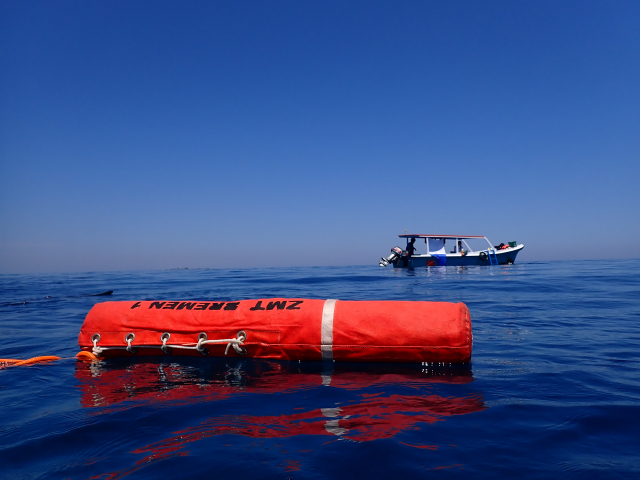This is a report from a 4D-REEF research expedition in Indonesia's Spermonde Archipelago by Estradivari, doctoral candidate in the WG Fish Ecology and Evolution, who calls it “an exercise in co-designing science between researchers from the Global North and Global South”.
Finally, I was able to go on an expedition to the Spermonde Islands in Indonesia after waiting for two years during the COVID-19 pandemic. In the month leading up to the expedition, I finalized the research concept, prepared all the logistics and research equipment, and took care of all the paperwork.
All set, and it was time to depart!
The 4D-Reef expedition began in early August 2022 in the Spermonde Archipelago, Indonesia, with an overarching goal to study the past, present, and potential future of turbid reefs (https://www.4d-reef.eu/). Besides me, researchers and PhD Candidates from a variety of research institutes participated in the expedition, including Dino Ramos (University of Granada, Spain), Andrew Torres (Natural History Museum/NHM, United Kingdom), Mike Hynes, Elsa Girard, Willem Renema (Naturalis Biodiversity Center, Netherlands), Roberto Giudici (Ocean Maps, Austria), Dedi Parenden, Singgih Afifa Putra, Agung Pratama, Gunawan Syafruddin, Puspita Lestari (Hasanuddin University/UNHAS, Indonesia), Daniel Christoph Schürholz (Max Planck Institute for Marine Microbiology, Germany), Stephanie Bröhl, and Marleen Stuhr (ZMT, Germany). Each researcher had their own research topic, which all were related to one another.
My research focuses on understanding the turf algae dynamic in urbanized coral reef systems in Spermonde Archipelago. The study was undertaken on eight islands in the Archipelago, representing an inshore–offshore reef gradient from the capital Makassar city. I followed the ZMT's SPICE project sites to allow a temporal comparison of the coral reef condition. The nine-day-long fieldwork lasted from August 18 to 31, 2022. Under this research scope, I applied several methods and experiments, including (1) photo transect to measure benthic community cover; (2) underwater visual census to assess reef fish diversity, abundance, and biomass; (3) chain transect to examine the complexity of coral reef structure (rugosity); (4) small-scale photo quadrat to measure the interactions/competitiveness between corals and algae; (5) underwater vacuum to sample sediments trapped in turf algae, and (6) video recording to observe fish grazing activities.
Wait, does it sound like a lot for a person to undertake all these different approaches in such a short time (nine days for eight sampling islands)? The answer is straightforward: I did not carry out all these methods alone. In fact, I collaborated with several researchers and students from Global North and Global South institutions and made this a joint research.
And this is my story of conducting collaborative research by implementing principles of co-designing science.
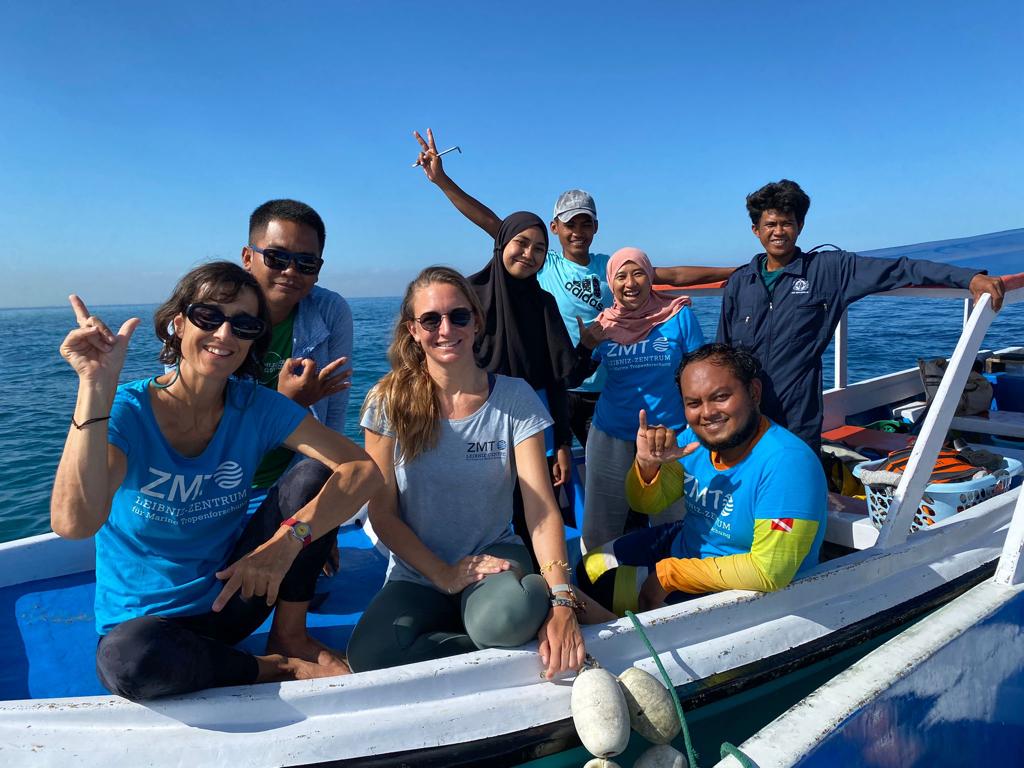
ZMT, UNHAS and NHM research team (Stephanie Bröhl, Marleen Stuhr, Agung Pratama, Estradivari and Puspita Lestari), and boat crew. Unfortunately, our colleague Gunawan Syafruddin could not join us that day because he was sick. Andrew Torres, who was part of the field team too, took this photo. (Photo: Andrew Torres)
Implementing science co-design principles for a collaborative PhD project
Collaboration in science is not new. Since the early days of scientific inquiry, people have worked together to exchange ideas and findings, and also to conduct experiments together. As the world has become more connected, so has science itself. Science collaboration can have diverse meanings and forms, from simply working with another researcher for a small research project to working together among key partners in a very well-established science setting. Science collaboration brings many benefits, such as multiplying the research outputs, improving the quality of the research, and expanding the use of scientific results.
Although science collaboration is essential and needs to be promoted continuously, there are concerns that one-sided collaborations, which can lead to so-called parachute science, have been implemented in many marine science projects worldwide. In this scheme, those collaborators with power and resources (e.g., funding, equipment, and expertise) dominate and rule the science project and often take the sole credit for science, with little involvement of other/local/weaker collaborators. To promote equitable collaboration in science and avoid parachute science from happening further, the UN Decade of Ocean Science for Sustainable Development has advocated “Co-designing the Science We Need for the Ocean We Want”. Co-design of science is characterized by strong engagement of relevant and multi-disiplinary stakeholders throughout all stages, equitable roles and responsibilities to implement science, as well as openness to embracing differences (e.g., research cultures, funding conditions), filling the knowledge or capacity gaps, and trying new approaches.
Although more and more researchers are getting involved, co-designed science is still relatively new. There is much to learn from both successful and unsuccessful projects. ZMT is one of the research institutes that embraces co-designed science; therefore, there's a good opportunity to apply science co-design principles in my PhD project.
Far before the expedition, a scheme for co-designing science among the different academic partners was planned in early 2021, in the early phase of my PhD. At that time, Dr. Sebastian Ferse (ZMT, my supervisor), Prof. Jamaluddin Jompa, Prof. Rohani Ambo-Rappe (UNHAS), and I discussed about implementing co-design of science for my PhD project by involving UNHAS students in the research project. We agreed for ZMT to provide the necessary expertise, training, mentoring, and resources (i.e., funding, equipment), and UNHAS to provide students, research topics, local expertise, and outreach to inform the scientific results.
As a follow-up, we searched and recruited four UNHAS students (three master students: Agung, Gunawan and Munawarrah, and one bachelor student: Puspita) and formed a core research team. Under the supervision of supervisors, this small research team worked closely together to develop and implement an integrative research project, capacity-building plan, and outreach strategies. The five of us had different but complementary research topics (Estra: turf algae, fish grazing, area-based management; Agung: interaction between corals and algae; Gunawan: turf algae sediments; Munawarrah: fish grazing, and Puspita: herbivore fish communities).
We met bi-monthly via Zoom to discuss different aspects of our study. In some events, I provided training in the use of R studio and statistical analysis to UNHAS faculty members and students, and UNHAS members provided local insights about the research area that are hardly known from searching on google or in the literature. Individual mentoring, meetings and chats were also happening throughout our journey. After working together virtually for the past 1.5 years via Zoom and WhatsApp, we finally had an opportunity to meet in person and conduct the fieldwork together. We worked as a team; we helped each other's research. Our collaboration does not stop here; we still have many plans in our pipeline for the next year, from analyzing the data, developing theses/scientific papers, to socializing our science results to wider audiences – and we will do these together.
Lessons learned from implementing co-design of science
It's not simple for researchers to work together to implement co-design of science, particularly when coming from different backgrounds and academic systems. Our 1.5-year journey has been filled with up-and-down moments, and these happened mostly because of different schedules, time zones, research culture, or seniority in science. There were times when we disagreed or had other ideas/opinions, and each wanted to make his/her point heard. In my case, as I am also Indonesian, language was not an issue in our collaboration; but this can be a problem if co-design of science is implemented in a multi-national team. Despite that, we have built trust and friendship along our journey. We have stronger and improved science capacity and networking than before. As a group, we are more productive scientifically than any of us could be working alone. With the local collaborators’ strong networking with key non-academic partners in the area, some of our findings can be used immediately to guide adaptive management.
Our successful collaboration is indeed the result of the combined efforts of all of us, the five core team members, with strong support from our supervisors and other key partners we have been working with. Although our journey probably can only represent a small part of the co-design process (for example, in our case it was restricted to academic actors), we've proven that co-designing science for students' projects is possible and feasible! We must keep trying, commit to the outputs, embrace the differences, regularly evaluate what worked and what did not, and be flexible to try new approaches. We've experienced that co-designing science has the potential to foster more inclusive and more impactful science; but only if we put in the time and effort to make this happen.
We are thankful to have the opportunity to put co-design of science into practice. Although we will not be able to work together as a team for a long time because we all have to graduate (soon-ish, fingers crossed!), we remain close friends – and potential future collaborators. We hope that the examples we have set through our successful use of co-designing science will encourage other students, PhD candidates, or research fellows to do the same.
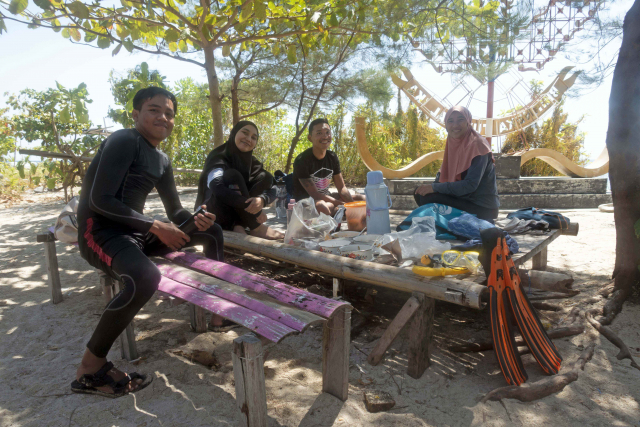
Lunch on the island between dives. We have Gunawan (on the left) and Andrew (man in the middle), two other team members, in this photo. (Photo: Marlen Stuhr)
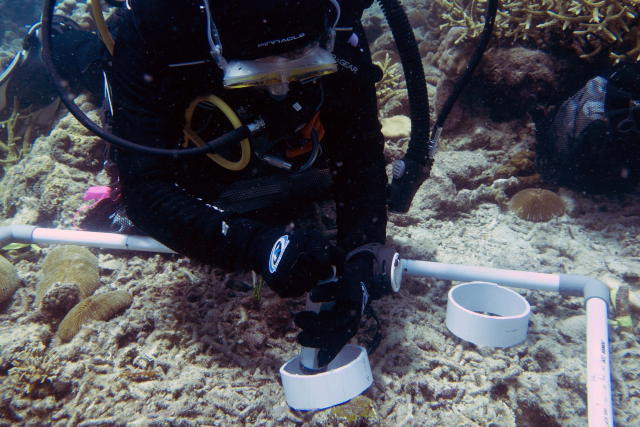
Estra sampling sediments within turf algae. (Photo: Andi M. A. Pratama)
Our field boat. (Photo: Estradivari)
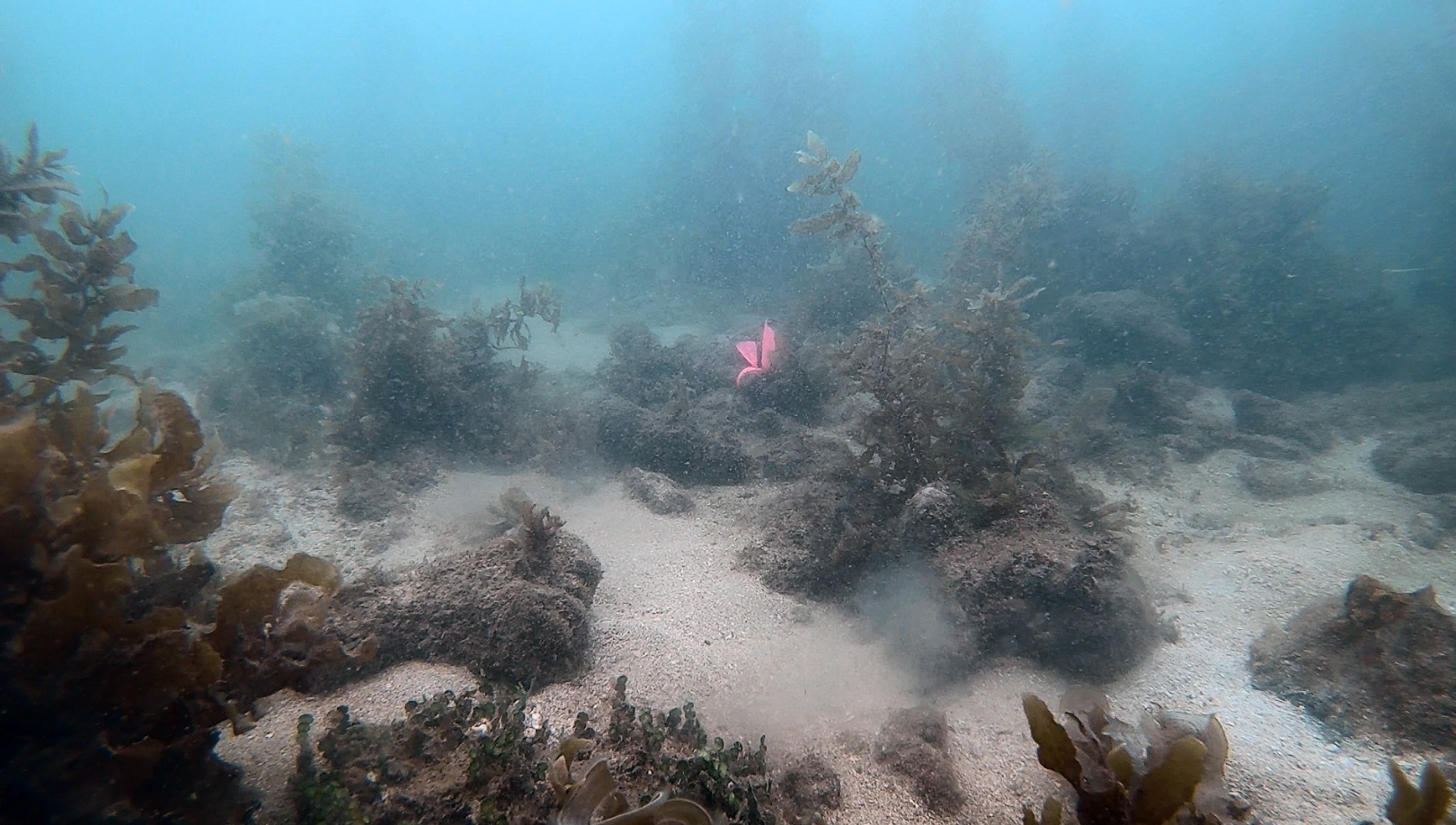

There was an inshore-offshore gradient from algae-dominated (e.g., reefs at 1 km from Makassar, photo above) to coral-dominated (e.g., reefs >20 km from Makassar, photo below) ecosystems in Spermonde Archipelago. (Photo: Estradivari (above) and Marleen Stuhr (below)
Acknowledgement
This expedition would not have been possible without the support and help of these ZMT colleagues; and a big appreciation goes to them: Sebastian Ferse, Sonia Bejarano, Oscar Puebla, Stephanie Bröhl, Marleen Stuhr (the last two joined the expedition, helped a lot with the data collection, and ensured safety diving under the European Scientific Diver framework), Michael Schmid, Ulrich Pint, Andreas Kunzmann, Christian Brandt (the European Scientific Diver instructors and ZMT's dive centre team), Timo Schumann, Mercè Sánchez, Svenja Ehlers, Heike Holtkamp, Susanne Boin (who have helped with all administrative matters) and Christian Wild (University of Bremen). I also need to write down several names from Hasanuddin University for their countless support and friendship; they deserve a thank you from all of us: Jamaluddin Jompa, Rohani Ambo-Rappe, Aidah Ambo Ala Husain, Munawarrah, Cici, Yaya, Sahlan, Agus, Iqbal, Masdar, the boat crews (Tiar and others) and many other new friends that I met during my trips to Makassar/Spermonde Archipelago. Last, another special thank is given to Andrew Torres (NHM), my fieldwork and dive buddy.





